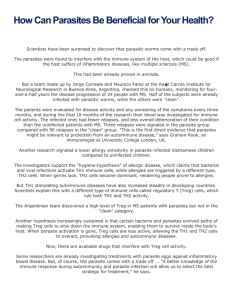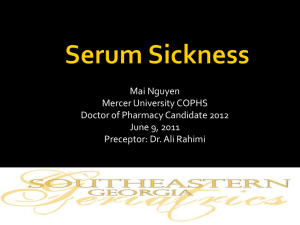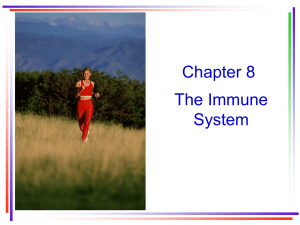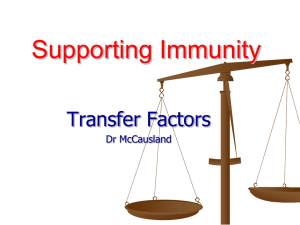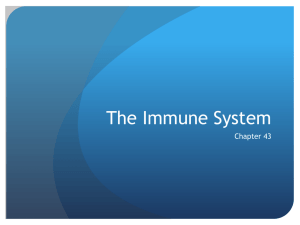immune response lecture2
advertisement
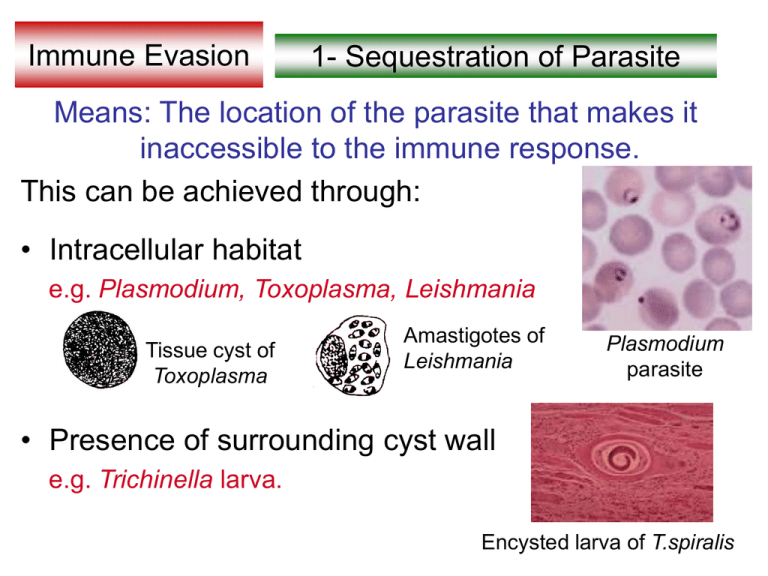
Immune Evasion 1- Sequestration of Parasite Means: The location of the parasite that makes it inaccessible to the immune response. This can be achieved through: • Intracellular habitat e.g. Plasmodium, Toxoplasma, Leishmania Tissue cyst of Toxoplasma Amastigotes of Leishmania Plasmodium parasite • Presence of surrounding cyst wall e.g. Trichinella larva. Encysted larva of T.spiralis 2- Luminal Habitat Intestinal parasites: e.g. Ascaris, Enterobius are less exposed to immune factors present in the mucosa 3- Parasite movement Adult Ancylostoma: move away from inflamed tissue to fresh areas. In larva migrans: Migrating larva escapes the immune response elicited locally. 4- Antigenic modification • Antigen variation: African trypanosomes, malaria parasites. • Antigen disguise: Parasites cover themselves with host proteins to be considered as self and will not be attacked by the immune factors e.g. adult Schistosoma. • Antigen mimicry: Parasites produce antigens similar to host antigens so they are not recognized by the host’s immune system e.g. Schistosoma. • Antigen shedding: Parasites shed their antigens in abundance can neutralize antibody response at a distance away from the parasite e.g. Schistosoma mansoni and Plasmodium falciparum. 5- Inhibition of Immune Factors • Cleavage of antibodies: parasite produces a protease enzyme that can cleave immunoglobulin molecule into Fab and Fc portions e.g. Trypanosoma cruzi. enzyme Fab Fc • Inactivation of complement: through: - Protease activity e.g. Schistosoma larva. - Acceleration of decay of complement e.g. Trypanosoma cruzi. - Ejection of membrane attack complex from their surface e.g. Leishmania. • Inhibition of macrophages by several inhibitory mechanisms so they can survive in macrophages e.g. Leishmania, Toxoplasma, Trypanosoma cruzi. X 6- Production of blocking antibodies Antibodies of little protective effect. Some helminths produce blocking Abs that combine with helminths Ags making them unavailable for antibodies of high protective effect (antibodies involved in ADCC) : e.g. Schistosoma 7- Immunosuppression Mediated through Ts cells e.g. Visceral leishmaniasis Give reason Schistosoma can evade the immune system Schistosoma cause: - antigen disguise. Host’s RBCs - antigen mimicry. - antigen shedding. - Cause inactivation of complement by protease activity. - Produce blocking antibodies. Give reason T.cruzi can evade the immune system T.cruzi : - can cause cleavage of antibodies. Protease enzyme - can accelerate decay of complement. - can inhibit macrophage. X Outcome of Immune Reponse Has duel effect on the host لها تأثير مزدوج على المريض Protective effect In the form of acquired immunity. Pathological effect In the form of damage to host’s systems and tissues. Protective Effect of the Immune Response 1- Immunity following healed infection e.g. Leishmania. Infection X Healed oriental sore Sandfly Solid immunity to re-infection ( strong immunity) 2- Immunity associated with persistent infection An immunity that is not efficient enough to eliminate the existing parasites but it partially protects the patient against re-infection Seen in: • Schistosomiasis: An immune response that does not kill adult worms but can kill re-infecting young schistosomula. Concomitant immunity • Falciparum malaria and toxoplasmosis: An immunity that makes infection asymptomatic and the patient becomes partially immune to re-infection. The parasites persist in small, slowly replicating numbers. Premunition When immune system is suppressed the infection flares up and symptoms reappear (recrudescence). Pathological effect of the immune response 1- Allergic reactions (type 1 hypersensitivity): IgE mediated allergy Mast cell Leaking hydatid fluid anaphylactic shock. Fascioliasis and larva migrans bronchial asthma. Early stages of schistosomiasis, fascioliasis, ascariasis Allergic dermatitis. Pathological Effect of the Immune response 2- Eosinophilic pneumonia: Migrating larvae of Ascaris and hookworms through the lungs. Loffler’s syndrome 3- Autoimmune reactions: Some parasites have antigens similar to host antigens. These will induce the production of antibodies (autoantibodies) that cross-react with host antigens e.g. in malaria and Chagas’ disease. 4- Deposition of immune complex (type 3 hypersensitivity reaction): Deposition in host tissues and activate the complement system resulting in host tissue damage e.g. Nephrotic syndrome complicating Plasmodium malariae infection. katayama fever occurring in acute schistosomiasis. 5- Granuloma formation (delayed type hypersensitivity): Cell-mediated reactions form granulomatous lesions around parasites e.g. Granuloma formation around Schistosoma eggs producing subsequent complications of the disease. 6- Immunosuppression: Secondary bacterial infection occurs death of infants and small children infected with visceral leishmaniasis. Vaccination - - No efficient vaccine preparation has yet been developed for human use against parasites. Why????? Complexity of the life cycle of the parasite makes the stage to be chosen for vaccine preparation difficult. Difficulty of identification and isolation of protective antigen to be used as vaccine. Possibility of inducing immunopathological lesions in response to the vaccine. Parasites may evade the immunity produced by the vaccine. Vaccine preparation may not be equally effective.


